Unheard Voices
The importance of a room of one's own, clearing the decks and the work of Kaff Gerrard
On finishing this week’s post I realised that it is my first anniversary of being here! Thank you to every one who has supported and subscribed over this time, it means a great deal and when I plunged in with that first post I never dreamt what a happy place this would turn out to be. From week to week I never know quite what I am going to do, but I love how it has given me the opportunity to make discoveries and share them with you here and your company is a continued pleasure.
Artemisia in a glass vase, oil on canvas Birmingham Museums Trust Copyright the artist’s estate
It has been a trying few weeks. I have been without my studio space for most of the summer, a place that though freezing in winter, is a blissfully cool, cave-like retreat to when the temperatures soar. Without going into the full horror of it, rats invaded the ceiling space and vacating my studio, until they were gone, was the only option. This meant moving much of my art stuff into a tiny study next to the kitchen and to try to continue in there. It was hopeless. Everything was on top on me and the constant interruptions from kitchen activity meant that very little was achieved. I lost the rhythm of working and have felt rather at sea as a consequence.
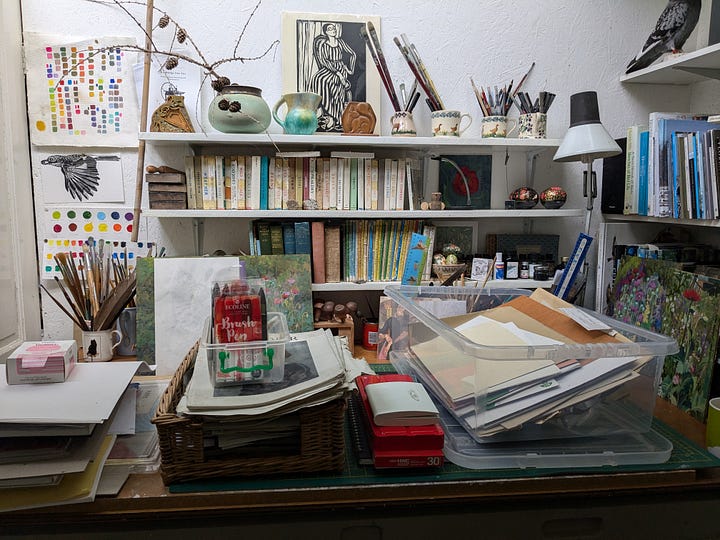
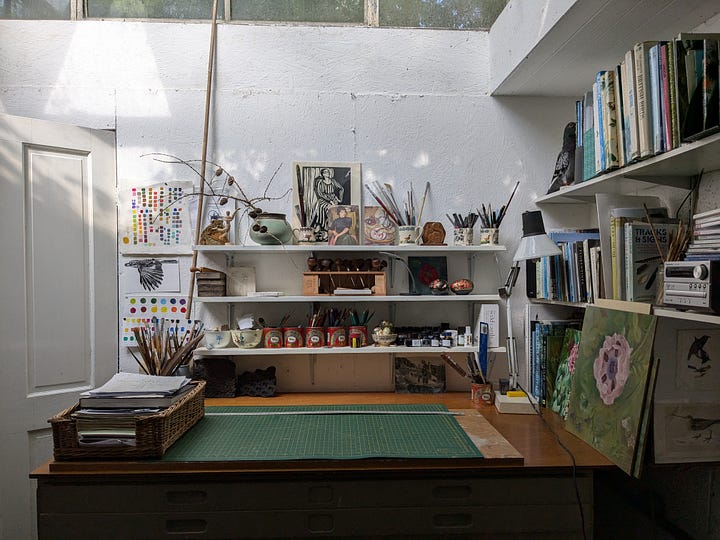

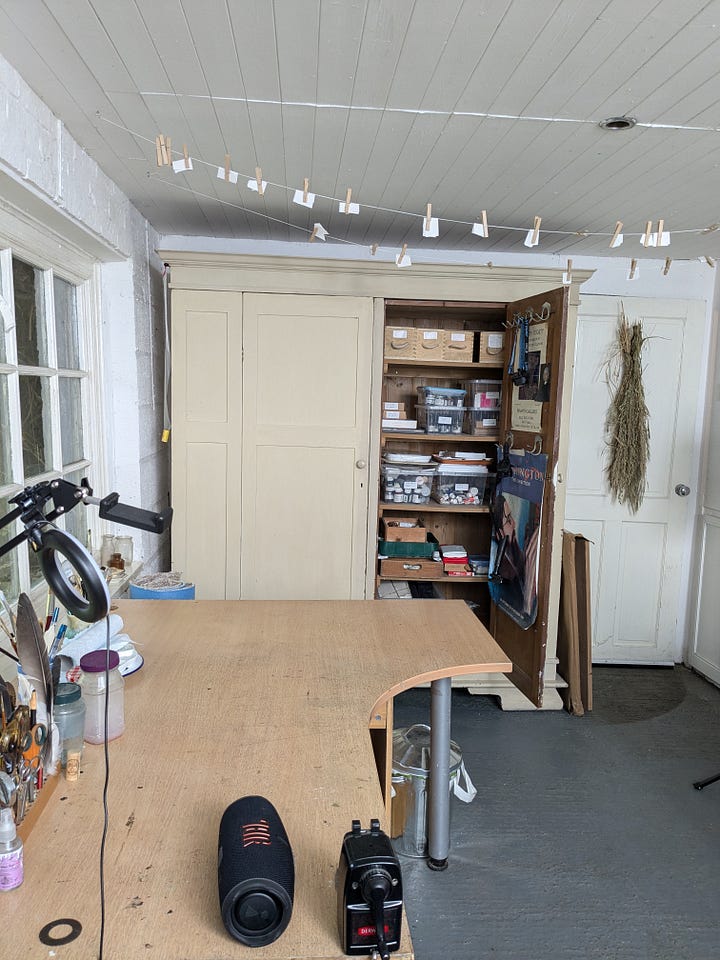
From mess to a clean slate. THe early photos were taken mid-sort - I fear initially it was much worse…
Over the last week, I have been returning these spaces back to order and took the opportunity to have a clean and clear-out. Getting rid of old work is hugely cathartic and I filled three bin liners in my sweep. The worst discovery was that my precious copies of Ladybird natural history books and Observer guides, which I love to keep by me, had been invaded and nibbled by Silverfish and so these have been thoroughly hoovered and brought indoors. But the resulting clarity has been a joy and I finally have a room of my own again.
Following this fresh start, I decided to go back to fundamentals. I hate the phrase “creative block”, it sounds so final, and instead I think “creative hiatus” much less forbidding. I know well enough now that such interludes do pass, though I confess that at the time it is sometimes hard to tell yourself this. One failsafe way to ignite the spark is gallery-going, seeing art that inspires, challenges and encourages you to remember why making art matters so much.
It was on one was such foray, a couple of weeks ago, to the Fitzwilliam Museum in Cambridge, while searching for a Samuel Palmer, that I was arrested by a tiny painting by an artist I had never seen before. It shows a chalk pit carved out in shell-like pastel tones. Its subject reminded me of Paul Nash, although the dry, surface texture was reminiscent of Gwen John, but this work had its own distinctive voice. I then read the caption underneath:
Kaff Gerrard was almost unknown in her lifetime. She lived with her husband in a converted dairy in the Kent countryside, where she also made ceramics and created a cottage garden alongside her painting. Gerrard’s works trace her daily walks along the South Downs in south-east England. The hills are rendered in matte patches of pinkish white paint that evoke the dryness of the chalk and echo the cloud floating above.
The Chalk Pit, oil on canvas, 1930’s THe Fitzwilliam Museum Copyright the artist’s estate
Why was this artist “almost unknown in her lifetime”, was it because, like so many other female painters of the early 20th century, she found following an artistic career in tandem with marriage and motherhood too difficult to pursue? So soon after seeing the work of Mildred Holland, and dwelling upon her challenges in creating her ceiling, I felt compelled to investigate. The only reference I found to her was in “Tate Women Artists” by Alicia Foster which outlines all the women artists held in the Tate collection.
Aside from the briefest biographical details, there were no further clues. Kaff Gerrard (born Katherine Leigh - Pemberton 1894-1970) had taken part in only one major exhibition in the Colnaghi Gallery in 1931, alongside her husband, head of sculpture at the Slade from 1925, and had shown not her paintings, but her ceramics. Even so, this exhibition had been greeted to great acclaim and would certainly have paved the way for further opportunities.
Cyclamen and Blue Jug, oil on canvas Government Art Collection Copyright the artist’s estate
This shift took place, in spite of being a Slade star pupil, winning first prize for painting from the cast in 1922 and for her portrait painting in 1923, and working under the exacting gaze of Henry Tonks and Wilson Steer, who described her as, “the most natural painter he had ever known at the Slade.” She took the path of working in isolation, walking daily on the Sussex Downs and creating a huge body of work alongside her husband in their home on the Kentish / Sussex border. Her garden also inspired many paintings and the flowers she depicts are typical cottage garden varieties, such as Canterbury bells, artemisia, peonies and poppies, as well as still lives of quinces and medlars.
Small fungus painting, oil on canvas The Fitzwilliam Museum Copyright the artist’s estate
While her work latterly focused on landscape, there were also paintings that emerged from forms found on her walks and of the twisted metal wreckage that scarred the Downs during the Second World War, three of which are held in the Imperial War Museum.
Bomb damage with cows, oil on canvas, c.1944 Imperial War Museum , London Copyright the artist’s estate
I wrote this piece with a particular thesis in mind, but as her story emerged, my assumption was shaken. I think in part it was informed by my knowledge of women artists of this period, so many of whom are now barely known, whose work dwindled upon leaving the Slade, owing to the difficulties of negotiating an artistic career, in combination with marriage, at a time when such choices were testing. As Virginia Woolf so powerfully made clear, having the equivalent of a “room of one’s own”, as well as a private income, servants and certainly in her case, a supportive husband, an artistic career was a significant obstacle.
While this is certainly true of many, in the case of Kaff Gerrard, a different story comes into view. It is unclear why she chose not to exhibit her work, but the choice of not exhibiting does not mean that she is not a significant artist, she simply chose not to seek acclaim. Choosing to paint for its own sake, to focus on creating work that strives to fulfill one’s own standard is a brave decision and a single minded one.
Her husband, as in the case of Mildred Holland, was hugely supportive, even carving hand made frames that enhanced her work. The decision to not exhibit was a shared one, he too chose not to, and together they worked, a couple dedicated both to art and each other.
In 1991, almost twenty years after her death, he was persuaded to show her work in a retrospective that was held at the Royal Museum and Art Gallery in Canterbury. It was an enormous success, received great critical acclaim and 51 of her paintings are now held in galleries across the UK, including the Tate and the Hepworth in Wakefield. One wonders how she would have felt about this? I hope she would have been proud.
Her work once seen is never forgotten, and never confused with that of anyone else. It combines technical mastery with personal vision in a way that only great art achieves. John Russell Tayor, The Sunday Times
Portrait of Kaff by her husband A.H.Gerrard Copyright the artist’s estate
Something to read
Two Weeks in September by R C Sheriff As we leave summer behind, this is the perfect read. Recommended to me by the Unhurried Reader, it is a beautifully, simply written tale of a good and decent family’s annual holiday to the South coast and it is this very ordinariness that makes it so special.
Someone to follow here
Hannah Nunn is a designer and maker inspired by meadows, seedheads and those tiny treasures we pick up on walks at this time of year. Her newsletter “Something I have noticed” has tranferred to here and is a weekly delight.
Something to watch
Shoulder to Shoulder I heard of this in Sian Phillip’s 90th birthday tribute where she said it was the work of which she was most proud, and rightly so. She plays Emmeline Pankhurst in six, ninety minute programmes that tell the history of the Suffragettes, each film focusing on a key figure. I confess I knew little before watching this, and I can’t imagine such a subject being given such space today, but it is compelling and fascinating, though sometimes a harrowing watch. There is also an interview with Phillips and the directors, now both in their 80’s, that is well worth seeing too. Watch out for a cameo by the young Bob Hoskins!
Barbara Hepworth As a balance to focusing on women painters, this remarkable half hour film by John Read from 1961 shows Hepworth at the height of her powers. Beautifully filmed, we see her walking the Penwith landscape, a diminuitive figure wielding her tools with such strength and exactness and then we see her creating drawings of such exquisite precision, filmed showing the shadow of her hand as she creates.
It may be that the sensation of being a woman presents another emphasis in art, particularly in terms of sculpture, for there is a whole range of perception belonging to experience so many ideas spring from an inside response to form. Barbara Hepworth
Freddie Flintoff’s Field of Dreams If you don’t know of this, and think it an odd inclusion, you are going to have to bear with me. I know nothing about cricket, but this matters not one jot. Although the second series is just being screened, watch the first series before it. Andrew Flintoff takes a group of young, isolated kids from Preston and builds them into a cricket team. It is a tale of friendship, kindness and love. It is completely magical - don’t miss it.
Thank you for taking the time to read this and for your continued company. This week’s was the first of an occasional series that will explore the unheard voices of women artists in the early 20th century, a passion of mine for some years, but this has given me the opportunity to delve deeper. If you enjoyed this post, it would be brilliant if you could press the “Heart” as it means non-subscribers get to see it too. As a small thank you to paid subscribers, you will receive a free print, of your choice, from my website shop and 20% off any orders- just contact me with your email address and I will be in touch.
I look forward to seeing you again in a couple of weeks!

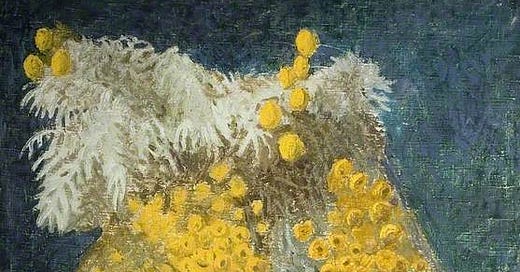



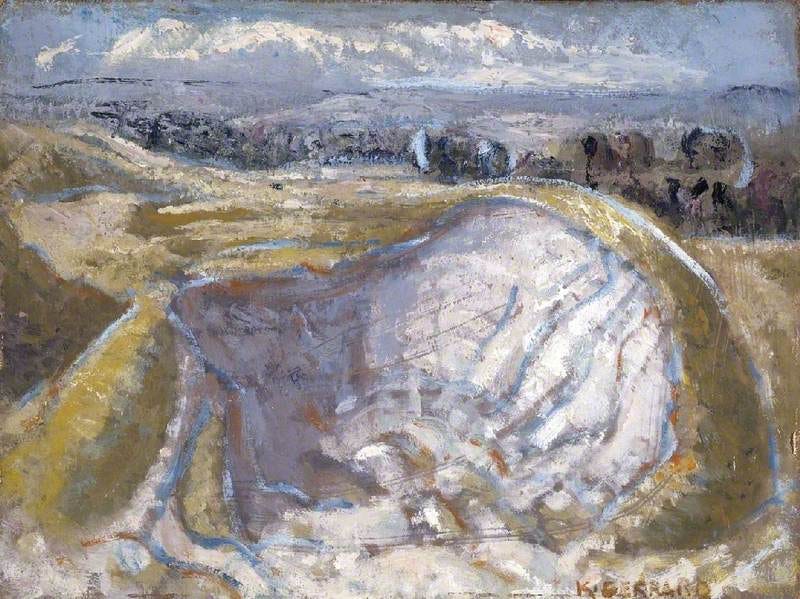
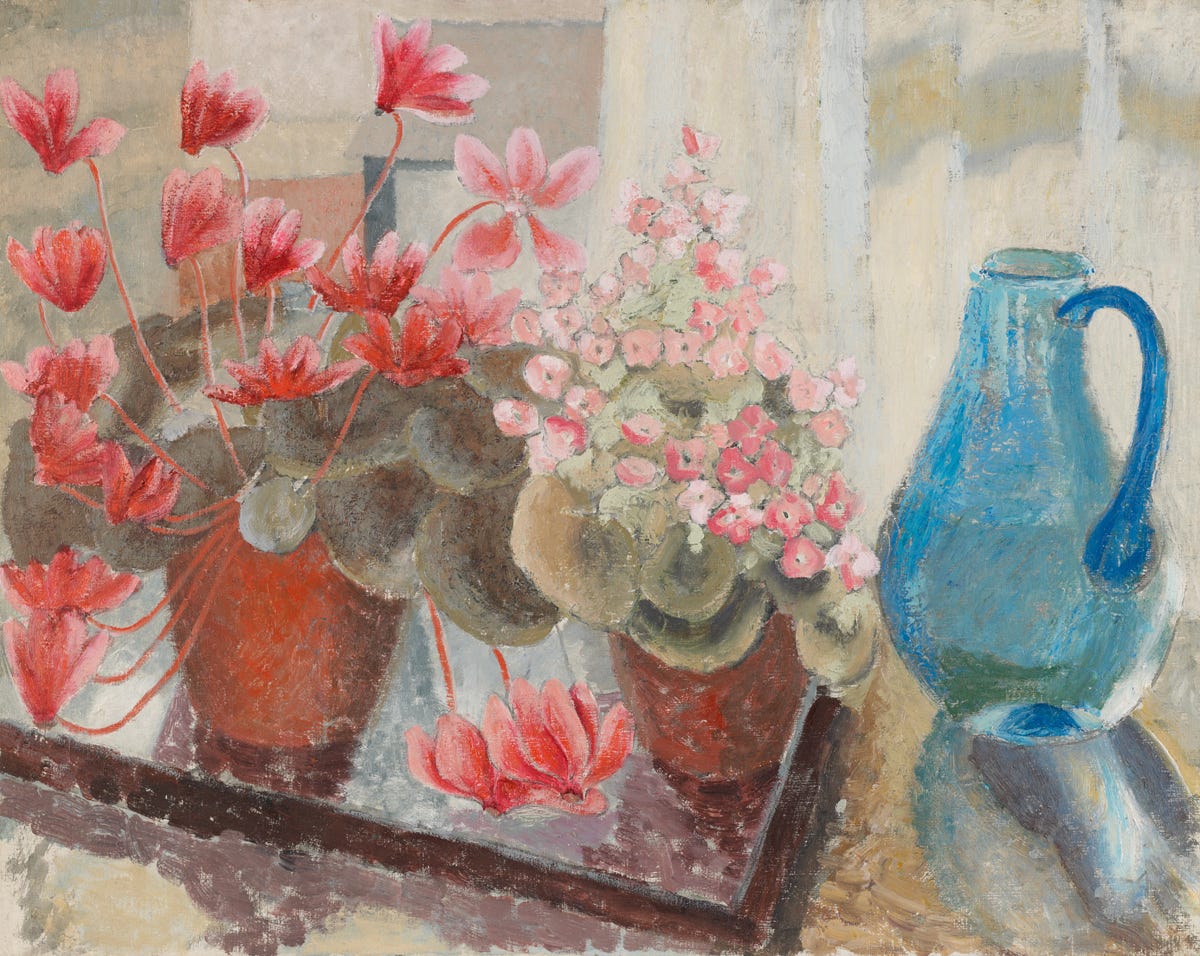
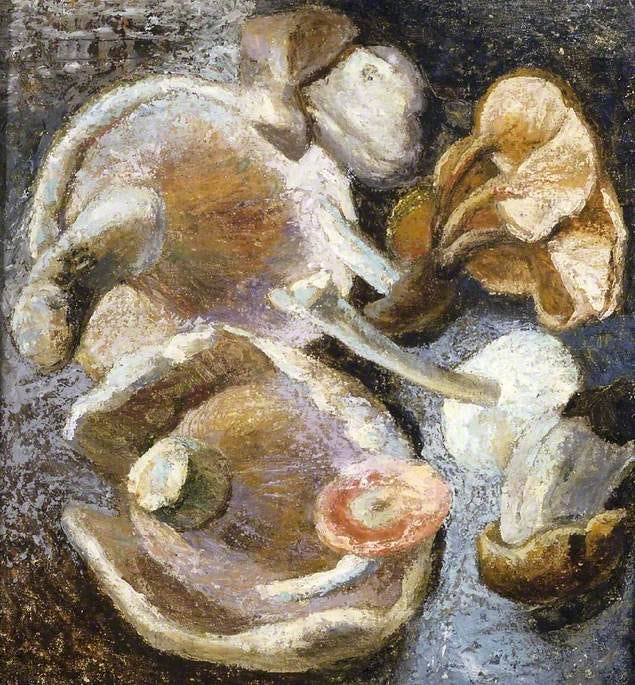
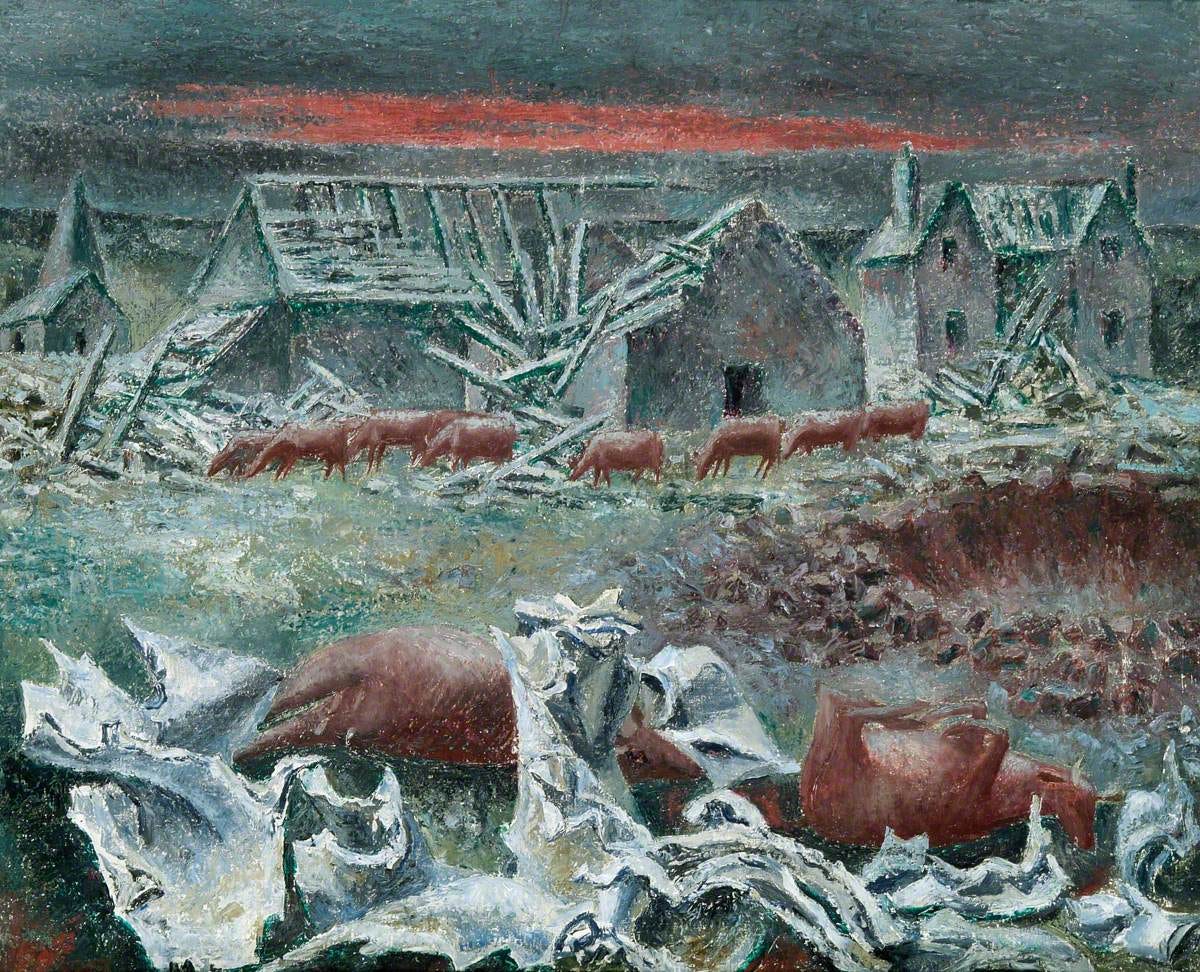

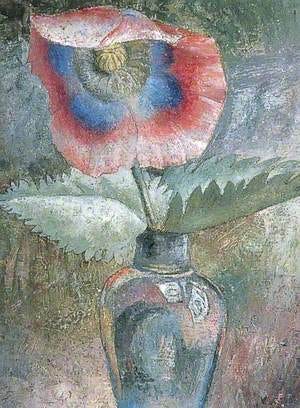
I always enjoy reading your posts. There is such a patience and familiarity about them, as if told at the kitchen table with a cup of tea in hand, and I dare not interrupt in case I miss a bit.
It is true to say that there is a power in having your own space and an independence as a creative person. Thank you for sharing the story of this incredible artistic talent, Kaff Gerrard. Taking the time to write a piece like this goes such a long way to bringing her into the light, despite what she may have wanted in her lifetime.
1 year, and here's to many more.
Hey, what an interesting post to read.
I knew nothing of Kath Gerrard, not even her name. I think her work is fascinating in its quality of repose (Cyclamen and Blue Jug)…and I really get John Russell Taylor (ever insightful) and his point about the personal quality of her vision (Bomb damage with cows). I really dig the Artemisia in a glass vase. I think her and her husband’s mutual decision not to show their work adds another layer of meaning to that (and put me in mind of Kate Atkinson who wrote about the delight of writing just for herself, with no intention of showing it to anyone else, let alone of publication); it seems a valuable counterpoint to the performative in art (and I say that in acknowledgement of my own delight at times in the performative) – it isn’t that interiority is more desirable than performative, or vice versa, it’s just the quality of privacy and interiority here in the pictures you’ve included, allied to the showing of the subjects through her painting, is both intriguing and calming.
I also found your idea on creative hiatus cool. I have always been tempted to be intolerant about the concept of creative block, finding it self-absorbed and indulgent – self-aggrandising even, making me want to say ‘stop getting in the way of yourself’ (as per Judith Jones to a whining author in an episode of the wonderful series Julia). But, creative hiatus seems a much more realistic term for the difficulties we all experience in creativity, a term which allows for the reality but also shows us a way forward and the imperative to find inspiration to work through that hiatus rather than wallow.
Thank you for a such a stimulating piece.